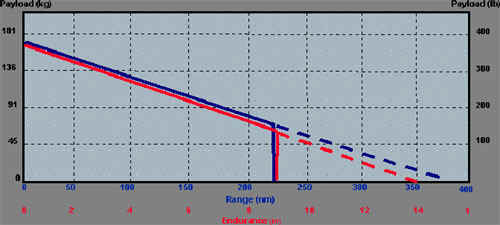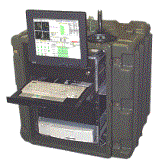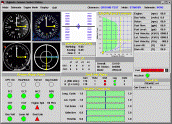 What is
Vigilanteä?
What is
Vigilanteä?
Vigilanteä is a SAIC developed family of Optionally Piloted and Unmanned Aerial Vehicles (UAV) that are available to fly your payload. These lightweight, low cost, highly capable air vehicles are based on the commercially available Ultrasport 496 sport helicopter. since the Vigilanteä is based on a kit it
uses a large number of Commercial Off-the-Shelf (COTS) components. Commercial production and use of COTS means fewer
spares required on hand and less expensive long-term support.

This
fully capable UAV system includes air vehicle and ground support systems. It is easily transported via trailer towed by
auto/truck/van. It is reconfigurable for
variety of datalinks and payloads. It can be
operated by as few as two people.
There are two variants
of Vigilanteä. Having both have a maximum gross weight of 1,100 pounds, a main rotor diameter of 23 feet, an overall length of 20 feet and a main rotor height of 7.5 feet. They
both have a shrouded tail rotor and the rotating tail rotor drive shaft enclosed in
tailboom for safety. All variants have high sink rate (900-fpm) landing gear and excellent autorotation
capabilities.
 The Vigilanteä 496 OPV is either optionally
piloted or an autonomously UAV. It is capable
of a maximum true air speed of 75 knots and ceiling of 12,000 feet. It has 12 cu ft
interior volume and a 300-lb. payload capacity with its full fuel capacity of 18 gallons. With its Hirth engine it has about 5 hours of
endurance.
The Vigilanteä 496 OPV is either optionally
piloted or an autonomously UAV. It is capable
of a maximum true air speed of 75 knots and ceiling of 12,000 feet. It has 12 cu ft
interior volume and a 300-lb. payload capacity with its full fuel capacity of 18 gallons. With its Hirth engine it has about 5 hours of
endurance.
 The Vigilanteä 500 is a UAV only aircraft. It is capable of a maximum true air speed of 117
knots and ceiling of 13,000 feet. It has 5 cu ft interior volume, a 150-lb. payload
capacity with its full 36-gallon fuel capacity in a crashworthy fuel system and less drag
for improved aerodynamic performance. It has
a Rotax 914 turbo engine.
The Vigilanteä 500 is a UAV only aircraft. It is capable of a maximum true air speed of 117
knots and ceiling of 13,000 feet. It has 5 cu ft interior volume, a 150-lb. payload
capacity with its full 36-gallon fuel capacity in a crashworthy fuel system and less drag
for improved aerodynamic performance. It has
a Rotax 914 turbo engine.
Payload can be traded for range and
endurance.

This
estimate based on a Vigilante 502 with an empty weight of 720 pounds:
- 4 gal /hr endurance at 30 to 40 knots
- 5 to 6 gal/hr in cruise at 80 knots, 30 minute reserve
The dashed line represents the
current fuel tank of 36 gallons. To meet
mission requirements it could be increased to a maximum of 58 gallons.
 The aircraft avionics system uses a high-quality navigation sensor, an integrated INS/GPS solution, an integrated air data system, whit robust fault detection and recovery. It has
a PC104-based processor suite using proven, off-the-shelf
hardware in a compact, easily accessible packaging using the low-cost Linux-based
operating system
The aircraft avionics system uses a high-quality navigation sensor, an integrated INS/GPS solution, an integrated air data system, whit robust fault detection and recovery. It has
a PC104-based processor suite using proven, off-the-shelf
hardware in a compact, easily accessible packaging using the low-cost Linux-based
operating system
 The Vigilanteä Ground Control Station is a complete system providing dynamic real-time
control of the Vigilante VTOL UAV. The
Vigilanteä Ground Control Software incorporates special controls and displays tailored
to the special requirements of rotary wing vehicles, especially distinguishing between
hovering and forward flight modes. The system
has provisions for multiple modes of operator interactions, including real-time flight
director style commands, supervised autonomy of waypoint-based navigation, and fully
autonomous flight (for recovery after lost link). The
ground station software suite includes control of redundant command and status data links,
real-time system safety monitoring functions, telemetry recording, and display/playback of
recorded data.
The Vigilanteä Ground Control Station is a complete system providing dynamic real-time
control of the Vigilante VTOL UAV. The
Vigilanteä Ground Control Software incorporates special controls and displays tailored
to the special requirements of rotary wing vehicles, especially distinguishing between
hovering and forward flight modes. The system
has provisions for multiple modes of operator interactions, including real-time flight
director style commands, supervised autonomy of waypoint-based navigation, and fully
autonomous flight (for recovery after lost link). The
ground station software suite includes control of redundant command and status data links,
real-time system safety monitoring functions, telemetry recording, and display/playback of
recorded data.
 The Ground control station features redundant
command/status RF links in 900 MHz and 2.4 GHz. There is also a 72 MHz backup safety pilot command
link and a 425 MHz flight termination link. A
variety of additional real-time sensing elements are recorded by the ground station
including: engine health & status instrumentation, EGT and
CHT, separate rotor and engine speed, electrical power system status, a radar altimeter
(0-600m), and an ultrasonic ground proximity warning system.
The Ground control station features redundant
command/status RF links in 900 MHz and 2.4 GHz. There is also a 72 MHz backup safety pilot command
link and a 425 MHz flight termination link. A
variety of additional real-time sensing elements are recorded by the ground station
including: engine health & status instrumentation, EGT and
CHT, separate rotor and engine speed, electrical power system status, a radar altimeter
(0-600m), and an ultrasonic ground proximity warning system.
Mission control is done via the GCS through redundant frequency-hopping digital datalinks having a 20 n. mi range. The operator may select levels of control authority over the vehicle ranging from hands-off, waypoint inputs (from A to B at C speed at D altitude) to joystick controlled velocity commands (climb at x rate, turn at y rate, cruise at z rate, etc). Automatic take off and land, pre-programmed lost link recovery, and emergency autorotations are also executed autonomously. Situational awareness is provided by digital maps, air vehicle health displays, and payload operations screens presented on the GCS display. A stand-alone Flight Termination System is available optionally.
 This ground control station is a hardware implementation
based on the field-proven SAIC Direct Dissemination Element (DDE) ground station for the
Global Hawk long endurance UAV. It provides a
complete ground control software suite, flight systems controls
and displays, data acquisition recording and file management and mission management tools.
This ground control station is a hardware implementation
based on the field-proven SAIC Direct Dissemination Element (DDE) ground station for the
Global Hawk long endurance UAV. It provides a
complete ground control software suite, flight systems controls
and displays, data acquisition recording and file management and mission management tools.
Its user-friendly interface
permits safe employment by low-time operators and its modular design permits rapid
incorporation of specialized interfaces.
 The
Vigilanteä system has also demonstrated integrated operation of a POP-100 EO/IR sensor
in flight.
The
Vigilanteä system has also demonstrated integrated operation of a POP-100 EO/IR sensor
in flight.
 The initial Flight Test Program has
demonstrated speeds up to 50kts, altitudes up to 500 ft (limited by test range) and ranges
out to 2 miles (limited by COTS datalink performance).
We have over 12 hours of flight time in autonomous flight modes and 150 hours of
airborne flight-testing.
The initial Flight Test Program has
demonstrated speeds up to 50kts, altitudes up to 500 ft (limited by test range) and ranges
out to 2 miles (limited by COTS datalink performance).
We have over 12 hours of flight time in autonomous flight modes and 150 hours of
airborne flight-testing.










